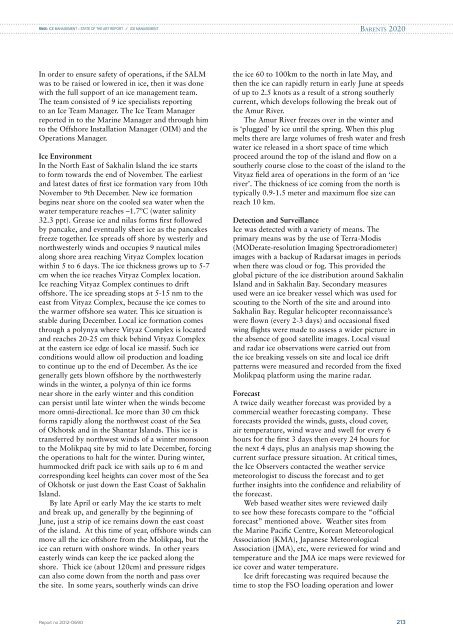phase 4 report - DNV
phase 4 report - DNV
phase 4 report - DNV
Create successful ePaper yourself
Turn your PDF publications into a flip-book with our unique Google optimized e-Paper software.
RN06: ICE MANAGEMENT – STATE OF THE ART REPORT // Ice ManagementBarents 2020In order to ensure safety of operations, if the SALMwas to be raised or lowered in ice, then it was donewith the full support of an ice management team.The team consisted of 9 ice specialists <strong>report</strong>ingto an Ice Team Manager. The Ice Team Manager<strong>report</strong>ed in to the Marine Manager and through himto the Offshore Installation Manager (OIM) and theOperations Manager.Ice EnvironmentIn the North East of Sakhalin Island the ice startsto form towards the end of November. The earliestand latest dates of first ice formation vary from 10thNovember to 9th December. New ice formationbegins near shore on the cooled sea water when thewater temperature reaches –1.7ºC (water salinity32.3 ppt). Grease ice and nilas forms first followedby pancake, and eventually sheet ice as the pancakesfreeze together. Ice spreads off shore by westerly andnorthwesterly winds and occupies 9 nautical milesalong shore area reaching Vityaz Complex locationwithin 5 to 6 days. The ice thickness grows up to 5-7cm when the ice reaches Vityaz Complex location.Ice reaching Vityaz Complex continues to driftoffshore. The ice spreading stops at 5-15 nm to theeast from Vityaz Complex, because the ice comes tothe warmer offshore sea water. This ice situation isstable during December. Local ice formation comesthrough a polynya where Vityaz Complex is locatedand reaches 20-25 cm thick behind Vityaz Complexat the eastern ice edge of local ice massif. Such iceconditions would allow oil production and loadingto continue up to the end of December. As the icegenerally gets blown offshore by the northwesterlywinds in the winter, a polynya of thin ice formsnear shore in the early winter and this conditioncan persist until late winter when the winds becomemore omni-directional. Ice more than 30 cm thickforms rapidly along the northwest coast of the Seaof Okhotsk and in the Shantar Islands. This ice istransferred by northwest winds of a winter monsoonto the Molikpaq site by mid to late December, forcingthe operations to halt for the winter. During winter,hummocked drift pack ice with sails up to 6 m andcorresponding keel heights can cover most of the Seaof Okhotsk or just down the East Coast of SakhalinIsland.By late April or early May the ice starts to meltand break up, and generally by the beginning ofJune, just a strip of ice remains down the east coastof the island. At this time of year, offshore winds canmove all the ice offshore from the Molikpaq, but theice can return with onshore winds. In other yearseasterly winds can keep the ice packed along theshore. Thick ice (about 120cm) and pressure ridgescan also come down from the north and pass overthe site. In some years, southerly winds can drivethe ice 60 to 100km to the north in late May, andthen the ice can rapidly return in early June at speedsof up to 2.5 knots as a result of a strong southerlycurrent, which develops following the break out ofthe Amur River.The Amur River freezes over in the winter andis ‘plugged’ by ice until the spring. When this plugmelts there are large volumes of fresh water and freshwater ice released in a short space of time whichproceed around the top of the island and flow on asoutherly course close to the coast of the island to theVityaz field area of operations in the form of an ‘iceriver’. The thickness of ice coming from the north istypically 0.9-1.5 meter and maximum floe size canreach 10 km.Detection and SurveillanceIce was detected with a variety of means. Theprimary means was by the use of Terra-Modis(MODerate-resolution Imaging Spectroradiometer)images with a backup of Radarsat images in periodswhen there was cloud or fog. This provided theglobal picture of the ice distribution around SakhalinIsland and in Sakhalin Bay. Secondary measuresused were an ice breaker vessel which was used forscouting to the North of the site and around intoSakhalin Bay. Regular helicopter reconnaissance’swere flown (every 2-3 days) and occasional fixedwing flights were made to assess a wider picture inthe absence of good satellite images. Local visualand radar ice observations were carried out fromthe ice breaking vessels on site and local ice driftpatterns were measured and recorded from the fixedMolikpaq platform using the marine radar.ForecastA twice daily weather forecast was provided by acommercial weather forecasting company. Theseforecasts provided the winds, gusts, cloud cover,air temperature, wind wave and swell for every 6hours for the first 3 days then every 24 hours forthe next 4 days, plus an analysis map showing thecurrent surface pressure situation. At critical times,the Ice Observers contacted the weather servicemeteorologist to discuss the forecast and to getfurther insights into the confidence and reliability ofthe forecast.Web based weather sites were reviewed dailyto see how these forecasts compare to the “officialforecast” mentioned above. Weather sites fromthe Marine Pacific Centre, Korean MeteorologicalAssociation (KMA), Japanese MeteorologicalAssociation (JMA), etc, were reviewed for wind andtemperature and the JMA ice maps were reviewed forice cover and water temperature.Ice drift forecasting was required because thetime to stop the FSO loading operation and lowerReport no 2012-0690 213






![Risk Based Pipeline Integrity Management [Compatibility Mode] - DNV](https://img.yumpu.com/50424229/1/190x146/risk-based-pipeline-integrity-management-compatibility-mode-dnv.jpg?quality=85)









